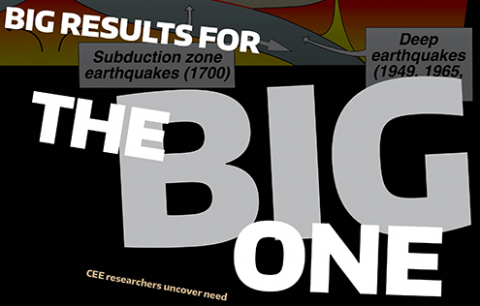March 1, 2022

It’s groundbreaking news, or perhaps ground shaking is more accurate: A new certificate program in earthquake engineering will be offered by the Civil & Environmental Engineering Department starting in spring quarter 2022.
Related story

Big results for ‘the big one’
Most people know that the Pacific Northwest is overdue for a catastrophic earthquake. But they may not know that CEE faculty are actively working to reduce the consequences.
“We are excited — this is something we’ve been wanting to do for a long time,” says Associate Professor Mike Motley. “We have a very strong program in earthquake engineering and want to offer people that additional background for structural design.”
With the goal of enabling engineers to design more resilient infrastructure, the certificate program is intended for practicing engineers, or those who are planning to work, in regions with an increased risk of seismic activity, which includes Washington, Oregon and California.
“There are some pockets around the rest of the country, but the majority of seismic activity is along the West Coast,” Motley says. “The ‘big one’ is also a West Coast phenomenon, which is an urgent concern.”
The Pacific Northwest is overdue for a Cascadia Subduction Zone earthquake, which makes the certificate program even more timely. The Cascadia Subduction Zone extends from Vancouver Island, B.C., in the north to Cape Mendocino, Calif. in the south. All structures located in a seismically active region must be designed following specific building codes, in order to meet a desired performance.
“There is a great demand for engineers with this skillset,” says Associate Professor Paolo Calvi. “The majority of design and consulting firms located on the West Coast of the U.S. and Canada predominantly hire engineers who can manage seismic-related issues. This is also becoming common for firms located in non-seismic regions too, because they want to successfully bid on projects located in seismic areas.”
Comprised of three courses, the certificate program can be completed in nine months. Classes cover a broad range of topics, from fundamentals to design to advanced topics. Students will gain a skillset beyond what is covered in traditional undergraduate earthquake design classes and will practice applying real-world seismic design concepts using structural analysis software and industry-standard approaches.
“We have a very high-quality program, as the classes offered are also part of our master’s and Ph.D. curriculum,” Calvi says. “Students will be exposed to the exact same material and held to the same exact standards as our UW graduate students.”
Jeffrey Berman
Paolo Calvi
Marc Eberhard
Travis Thonstad
Held online with live lectures, the classes will be taught by CEE faculty, several of whom have conducted research on the Cascadia Subduction Zone earthquake through the M9 Project. Instructors include faculty Jeffrey Berman, Paolo Calvi, Marc Eberhard and Travis Thonstad.
Learn how to apply
Applicants are expected to have a bachelor’s degree in civil engineering, as well as graduate-level knowledge of structural dynamics and professional experience in structural engineering. Applications are due March 14.